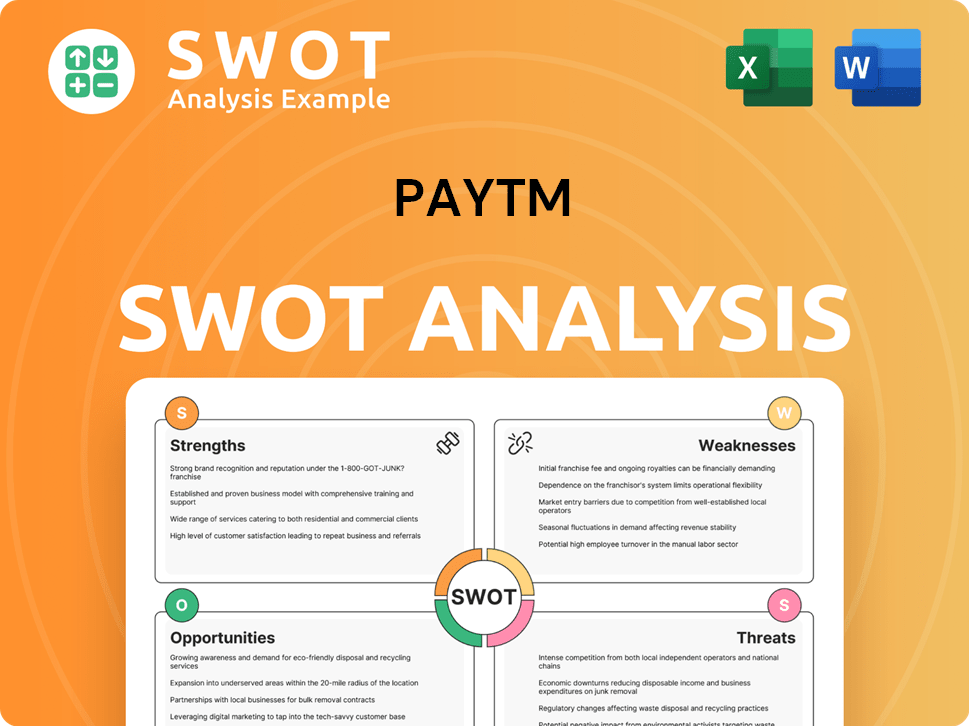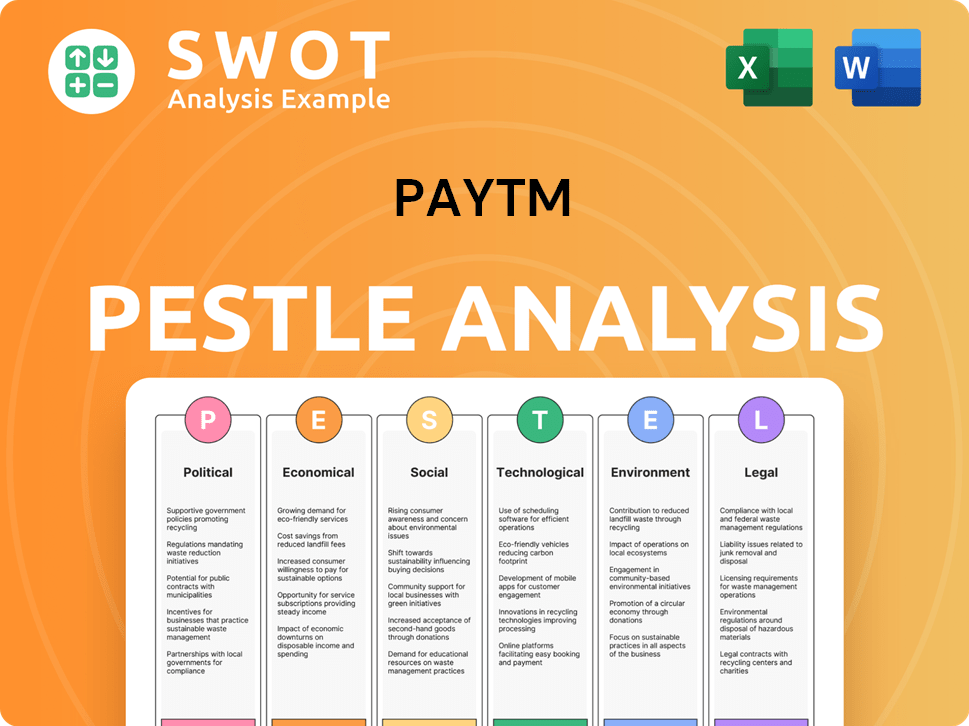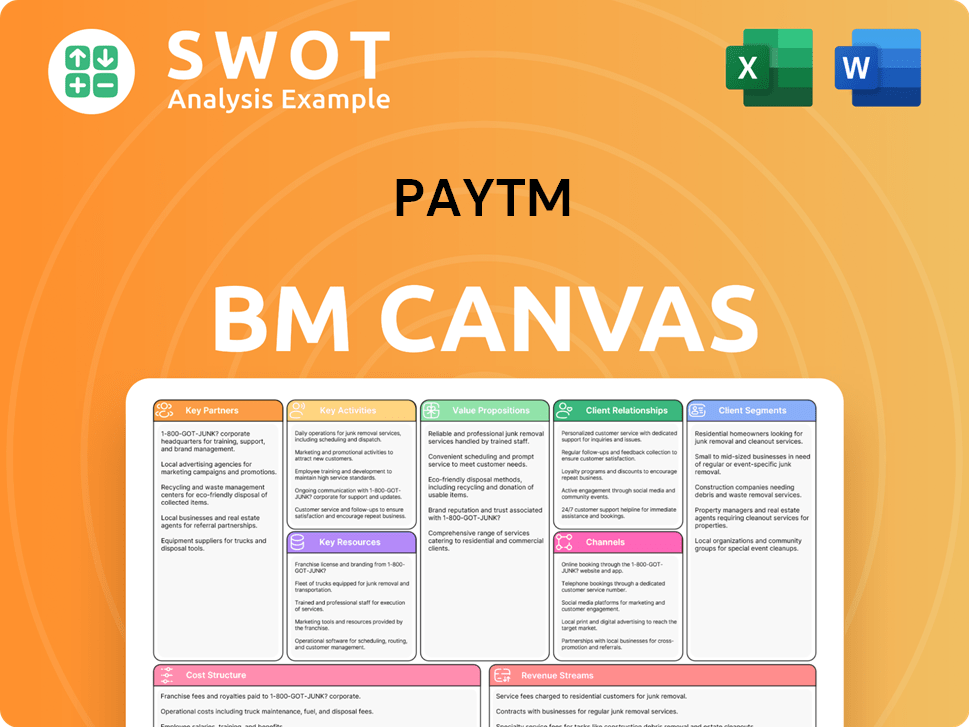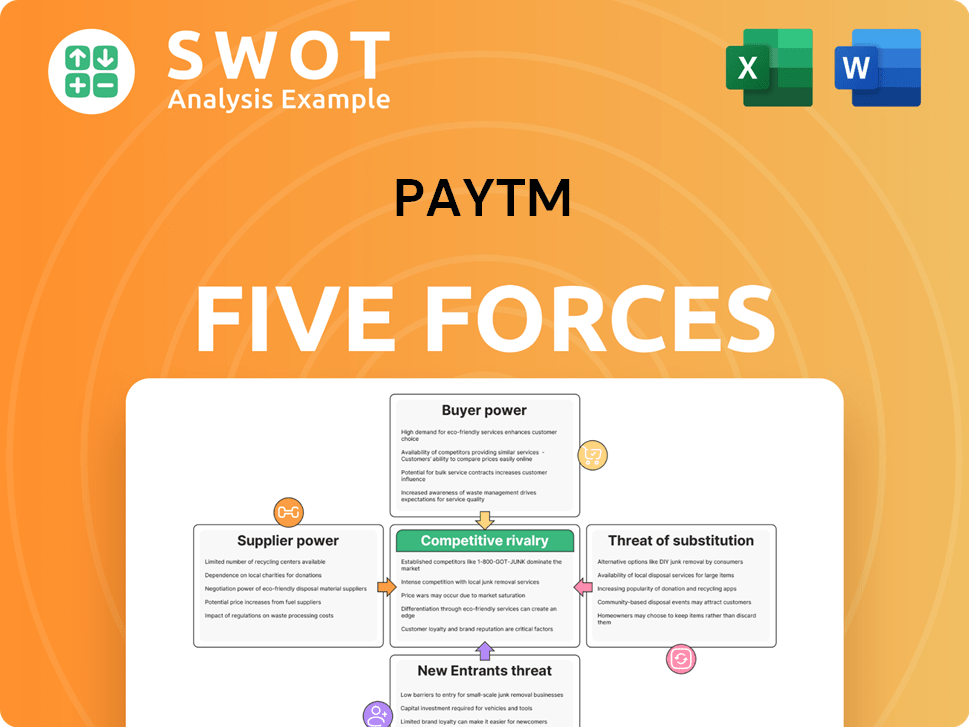Paytm Bundle
Decoding Paytm: What Drives Its Strategy?
Ever wondered what fuels the digital giant Paytm? Delving into its mission, vision, and core values unveils the heart of its operations and strategic direction. Understanding these elements is key to grasping Paytm's ambitions in the dynamic fintech landscape.

Paytm's Paytm SWOT Analysis can be a great tool to understand its positioning. Exploring "What is Paytm's mission statement?" and "Paytm's vision for the future" provides a roadmap for understanding the company's commitment to its users and its long-term goals, especially considering its focus on operational efficiency and profitability. Examining the "Core values of Paytm India" helps illuminate how Paytm's core values guide decision-making and shape its corporate identity within the financial sector.
Key Takeaways
- Paytm aims to integrate 500M Indians into the economy, driving digital excellence and growth.
- Core values like excellence, integrity, and teamwork are fundamental to Paytm's operations.
- Strategic adjustments, cost management, and compliance are key to Paytm's resilience.
- Expanding its merchant network and leveraging AI are crucial for future growth.
- Aligning with its mission, vision, and focusing on financial inclusion will be key for Paytm's success.
Mission: What is Paytm Mission Statement?
Paytm's mission is 'to bring Half-a-Billion Indians to the Mainstream Economy'.
Let's delve into the core of Paytm's purpose and how it shapes the company's operations and strategic direction.
The central tenet of the Paytm Company mission is financial inclusion. This means actively working to integrate a significant portion of India's population into the formal economic system. It’s about providing access to financial tools and services to those who may have been previously excluded.
A key aspect of Paytm's mission is to focus on the unserved and underserved segments of the Indian population. This includes individuals and small businesses who may not have had easy access to banking services, digital payments, or other financial products. This is a core element of Paytm's mission and vision.
Paytm offers a range of products and services designed to facilitate its mission. These include payment solutions, e-commerce platforms, and financial services. The goal is to provide a comprehensive ecosystem that meets diverse financial needs, contributing to Paytm's goals.
Paytm's mission is firmly rooted in the Indian market. The company focuses on understanding the unique needs and challenges of the Indian population and tailoring its offerings accordingly. This localized approach is crucial for achieving its objectives.
Paytm leverages technology to simplify access to financial tools and services. This technological advantage is a key differentiator, enabling the company to reach a large, previously excluded demographic efficiently. This approach reflects Paytm's long-term vision and goals.
Paytm's mission is strongly customer-centric, with a clear focus on empowering a large segment of the population through access to financial services. This customer-first approach is a core part of how Paytm defines its core values.
Paytm's mission is reflected in its operational metrics. For example, as of early 2024, Paytm's platform serves over 300 million registered users and has a network of over 20 million merchants. These figures demonstrate the company's significant impact on bringing more individuals and small businesses into the digital payment ecosystem, directly contributing to its mission. The company's commitment to its mission is evident in its continued investment in technology and expansion of services. Paytm's mission in the financial sector is clear: to drive financial inclusion and empower the Indian population.
Paytm SWOT Analysis
- Complete SWOT Breakdown
- Fully Customizable
- Editable in Excel & Word
- Professional Formatting
- Investor-Ready Format

Vision: What is Paytm Vision Statement?
Paytm's vision is to be the leading platform for digital excellence, drive substantial earning growth, and capitalize on cross-selling opportunities.
Let's delve into the specifics of Paytm's vision.
Paytm aims to achieve digital excellence by continuously innovating and improving its technology and user experience. This includes enhancing its payment infrastructure, expanding its financial services offerings, and leveraging technologies like AI. This focus is crucial for achieving its Paytm Vision.
The company's vision explicitly includes a focus on earning growth. This involves increasing revenue streams, improving profitability, and achieving sustainable financial performance. Recent financial reports show improvements in EBITDA before ESOP costs, indicating progress towards this goal. Understanding the Paytm Goals is essential.
Paytm intends to capitalize on cross-selling opportunities by offering a wide range of financial products and services to its existing customer base. This strategy aims to increase customer lifetime value and diversify revenue streams. The Paytm Objectives are clear in this regard.
While not explicitly stated, Paytm's vision implies ambitions for market leadership in the digital payments and financial services sector. Achieving digital excellence and driving earning growth are key steps towards this goal. The Paytm Company is positioning itself for long-term success.
Based on Paytm's current trajectory and market position, the vision appears realistic yet aspirational. The company has been actively expanding its financial services, such as lending and wealth management, which supports its vision. The Paytm Mission complements this vision.
Paytm's strategic focus on payments, credit, and wealth management, along with the use of AI for efficiency, supports the pursuit of digital excellence and earning growth. Recent financial results, including improvements in EBITDA before ESOP costs, indicate progress towards realizing this vision. For more context, consider reading a Brief History of Paytm.
This vision statement reflects Paytm's commitment to innovation, growth, and customer-centricity, setting the stage for its future endeavors and market position.
Paytm PESTLE Analysis
- Covers All 6 PESTLE Categories
- No Research Needed – Save Hours of Work
- Built by Experts, Trusted by Consultants
- Instant Download, Ready to Use
- 100% Editable, Fully Customizable

Values: What is Paytm Core Values Statement?
Understanding the core values of Paytm is crucial to grasping the company's operational ethos and its approach to achieving its objectives. These values shape Paytm's culture, guide its strategic decisions, and influence its interactions with customers, partners, and stakeholders.
Excellence at Paytm is reflected in its commitment to developing innovative and seamless digital payment solutions. This value drives the company to continuously improve its platform's user experience and reliability, which is particularly important given the competitive landscape and regulatory scrutiny. For example, in Q4 2024, Paytm reported a 13% year-on-year increase in its merchant base, demonstrating its focus on expanding its services and achieving excellence in execution.
Integrity is a cornerstone value for Paytm, especially in the financial services sector. This commitment is demonstrated through adherence to regulatory standards and building trust with customers and partners. Following recent challenges, Paytm has emphasized a 'compliance-first approach' across its businesses, reinforcing its dedication to ethical conduct and transparency. The company's efforts to enhance its risk management framework reflect its commitment to maintaining integrity.
Quality at Paytm encompasses the reliability and security of its platform and services, as well as the quality of customer service and financial products offered. Ensuring a high-quality user experience is crucial for retaining customers and attracting new ones in a competitive market. Paytm's focus on enhancing its technology infrastructure and customer support systems reflects its commitment to providing high-quality services. In 2024, Paytm processed an average of 8.5 million transactions per day, underscoring the importance of maintaining platform quality.
The 'Will to Win' value reflects Paytm's entrepreneurial spirit and its drive to achieve its goals and market leadership. Despite facing market challenges and competition, Paytm continues to pursue growth initiatives, expand its merchant network, and explore new opportunities. This is evident in its ongoing efforts to innovate and expand its service offerings, such as the introduction of new financial products and services. The company's ability to adapt and grow is a testament to its 'Will to Win' attitude. To understand more about Paytm's strategic approach, you can also read about the Growth Strategy of Paytm.
These core values of Paytm, including its mission to drive financial inclusion and its vision for digital payments, are central to its identity and strategic direction. The next chapter will explore how these key elements influence the company's strategic decisions and overall business strategy.
How Mission & Vision Influence Paytm Business?
Paytm's Paytm Mission and Paytm Vision are not just aspirational statements; they are the guiding stars that steer the company's strategic decisions and long-term direction. These statements influence every aspect of the business, from product development to market expansion.
Paytm's mission to bring half a billion Indians into the mainstream economy directly fuels its expansion strategy. This involves broadening its reach to underserved populations and developing inclusive financial products.
- Merchant Network Growth: Paytm aggressively expands its merchant network to enable digital payments for a wider population.
- Financial Inclusion: Focus on serving the unbanked and underbanked segments of the population.
- Geographic Expansion: Targeting Tier 2 and Tier 3 cities and rural areas.
- Product Innovation: Developing products tailored to the needs of diverse customer segments.
As of March 2025, Paytm's merchant subscriber base had expanded by 800,000, reaching 12.4 million. This expansion directly supports the Paytm Goals of bringing more businesses into the digital economy, aligning with its mission of broader financial inclusion.
Paytm's vision of achieving digital excellence and earning growth shapes its product development strategies. This includes adopting new technologies, diversifying revenue streams, and enhancing user experience.
The increasing focus on financial services revenue, particularly through lending, insurance, and wealth management, is a direct result of the Paytm Vision to increase earning growth. This includes cross-selling opportunities within their large user base, estimated between 200 and 250 million users.
Paytm's adoption of AI-led efficiency and productivity initiatives reflects its pursuit of digital excellence and cost savings, which are crucial for achieving profitability. This includes helping small merchants and micro-businesses, aligning with its mission of financial inclusion.
CEO Vijay Shekhar Sharma has consistently emphasized the company's commitment to profitability and its focus on digital transactions. He has also highlighted credit and wealth management as key growth drivers, reflecting the company’s strategic direction.
Measurable success metrics that demonstrate this alignment include the growth in the merchant subscriber base, the increase in financial services revenue, and the progress towards achieving profitability. The company reported a narrowed net loss in Q4 FY25 and aims for profitability in the upcoming quarters.
The strategic decisions of Paytm Company, from product development to market expansion, are deeply influenced by its Paytm Mission, Paytm Vision, and Paytm Core Values. These elements work together to guide the company's actions and shape its long-term objectives. To gain a deeper understanding of how Paytm is structured to achieve its objectives, you might find insights in Revenue Streams & Business Model of Paytm. Next, we'll delve into the core improvements to the company's mission and vision.
Paytm Business Model Canvas
- Complete 9-Block Business Model Canvas
- Effortlessly Communicate Your Business Strategy
- Investor-Ready BMC Format
- 100% Editable and Customizable
- Clear and Structured Layout

What Are Mission & Vision Improvements?
While Paytm's current statements provide a foundation, strategic refinements can enhance their alignment with evolving market dynamics and future opportunities. These improvements aim to solidify Paytm's position as a leader in the fintech space, ensuring its continued relevance and success.
To stay ahead, Paytm should explicitly integrate a stronger focus on technological innovation within its vision. This could involve directly referencing pioneering technologies like AI, blockchain, and other emerging areas to reflect its strategic initiatives. For example, integrating AI-driven personalization could increase user engagement by 15-20%, as seen in other fintech applications.
Given the growing importance of ESG factors, explicitly stating a commitment to sustainability and social responsibility within the Paytm Core Values would be beneficial. This could involve outlining initiatives related to environmental impact reduction through digital payments, which can reduce paper usage by up to 70%, and promoting financial inclusion, which has the potential to increase the GDP of developing nations by 1-2%.
As Paytm Company explores international expansion, the Paytm Vision statement could be broadened to reflect global aspirations. This would signal ambitions beyond the domestic market and position Paytm as a future-ready company. Expanding into new markets can increase revenue by 20-30% annually, as seen in successful fintech expansions.
To address emerging technologies, changing consumer behaviors, and sustainability concerns, Paytm might need to adapt its Paytm Mission and Paytm Vision to remain relevant and competitive. This could involve emphasizing the role of AI in personalizing financial services, highlighting the benefits of digital payments in reducing environmental impact, and outlining a clear strategy for international growth, as discussed in the article Target Market of Paytm.
How Does Paytm Implement Corporate Strategy?
Implementing a company's mission, vision, and core values is crucial for translating strategic intent into tangible actions and outcomes. This involves aligning operational strategies, business initiatives, and organizational culture to reflect the stated principles.
Paytm, a prominent player in the Indian fintech landscape, demonstrates its commitment to its Owners & Shareholders of Paytm through various implementation strategies. These strategies aim to translate the company's mission, vision, and core values into actionable business practices. The company's approach involves a combination of strategic initiatives, operational adjustments, and a focus on stakeholder communication.
- Merchant Network Expansion: Continuous expansion of the merchant network, including the deployment of payment devices like the Soundbox, which enables even small businesses in remote areas to accept digital payments.
- Financial Services Products: Development and promotion of financial services products, such as lending and wealth management.
- Compliance-First Approach: Emphasis on a 'compliance-first approach' and efforts to improve regulatory adherence, especially after the RBI's actions in 2024.
- Technological Integration: Investment in AI for efficiency and a focus on building AI-first products for small merchants.
Paytm's leadership, particularly Vijay Shekhar Sharma, plays a vital role in reinforcing the company's mission and vision. Sharma's vocal advocacy for financial inclusion and profitability demonstrates the commitment to these goals. This top-down approach helps ensure that the core principles are consistently communicated and integrated throughout the organization.
Specific initiatives showcase how Paytm's mission and vision are put into action. The expansion of the merchant network directly supports the mission of bringing more Indians into the mainstream economy. The development of financial services products exemplifies the vision of increasing earning growth and leveraging cross-selling opportunities. These are concrete examples of how the company works towards its Paytm Goals.
Communication of the Paytm Mission and Paytm Vision to stakeholders is a critical aspect of implementation. This is likely done through corporate announcements, investor presentations, employee training programs, and the company's official website and reports. Transparency in communication builds trust and ensures that all stakeholders understand and support the company's direction.
Paytm's focus on cost efficiencies, strategic pivots, and a renewed emphasis on compliance suggests a concerted effort to align operations with its strategic objectives and Paytm Core Values. The investment in AI and the focus on building AI-first products for small merchants also indicate a systematic approach to leveraging technology in line with their mission and vision. This is how Paytm Company achieves its Paytm Objectives.
Paytm Porter's Five Forces Analysis
- Covers All 5 Competitive Forces in Detail
- Structured for Consultants, Students, and Founders
- 100% Editable in Microsoft Word & Excel
- Instant Digital Download – Use Immediately
- Compatible with Mac & PC – Fully Unlocked

Related Blogs
- What are Mission Vision & Core Values of Paytm Company?
- What is Competitive Landscape of Paytm Company?
- What is Growth Strategy and Future Prospects of Paytm Company?
- How Does Paytm Company Work?
- What is Sales and Marketing Strategy of Paytm Company?
- Who Owns Paytm Company?
- What is Customer Demographics and Target Market of Paytm Company?
Disclaimer
All information, articles, and product details provided on this website are for general informational and educational purposes only. We do not claim any ownership over, nor do we intend to infringe upon, any trademarks, copyrights, logos, brand names, or other intellectual property mentioned or depicted on this site. Such intellectual property remains the property of its respective owners, and any references here are made solely for identification or informational purposes, without implying any affiliation, endorsement, or partnership.
We make no representations or warranties, express or implied, regarding the accuracy, completeness, or suitability of any content or products presented. Nothing on this website should be construed as legal, tax, investment, financial, medical, or other professional advice. In addition, no part of this site—including articles or product references—constitutes a solicitation, recommendation, endorsement, advertisement, or offer to buy or sell any securities, franchises, or other financial instruments, particularly in jurisdictions where such activity would be unlawful.
All content is of a general nature and may not address the specific circumstances of any individual or entity. It is not a substitute for professional advice or services. Any actions you take based on the information provided here are strictly at your own risk. You accept full responsibility for any decisions or outcomes arising from your use of this website and agree to release us from any liability in connection with your use of, or reliance upon, the content or products found herein.